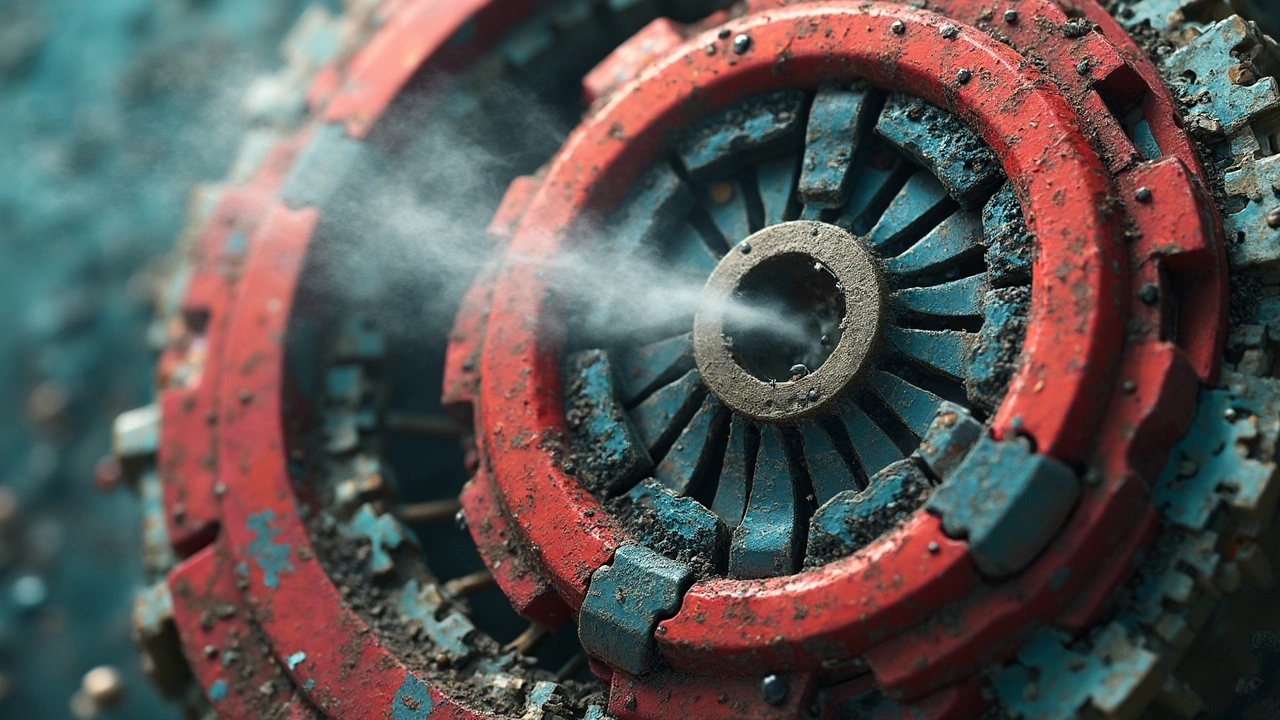A brand new clutch should work seamlessly, right? Well, that's what most people think. But just like any other car part, a new clutch can still have its hiccups. You've got your car back from the shop, expecting smooth rides, but then—bam! The clutch slips. What's going on?
First off, let's clear the air. A clutch can slip due to a few funky reasons. Could be a mishap during installation, like someone not quite tightening things up enough. Or maybe there’s a defective part. Even the nicest clutches aren’t shielded from manufacturing glitches.
Here’s a hot tip: Pay attention to your clutch pedal. If it feels spongy or you find it releasing too soon, you might be dealing with a slip. No need to panic, though. It's not the end of the world—yet. Sometimes, it's as simple as getting everything realigned properly.
- Understanding Clutch Basics
- Common Reasons for Clutch Slipping
- Proper Installation and Setup
- Signs Your Clutch is Slipping
- Preventing Future Slip Issues
- When to Seek Professional Help
Understanding Clutch Basics
Alright, let's break down what a clutch actually is. Think of it as a mediator between your car's engine and the wheels. The clutch's main gig is to let you shift gears smoothly without grinding anything or stalling the car. In a manual transmission, it's all about letting you engage and disengage different gears as you drive.
The key parts of a clutch? You've got the flywheel, clutch disc, pressure plate, and a release mechanism (often called a throw-out bearing or slave cylinder). When you press the clutch pedal, you're basically disengaging the engine from the wheels, allowing you to switch gears or come to a stop without killing the engine.
The Clutch Pedal Dance
Pressing down the clutch pedal moves the release mechanism, separating the clutch disc from the flywheel. The disengagement process is why you don’t stall when stopping at a light. When you let go of the pedal, the clutch disc connects back to the flywheel, and you're off to the races—literally.
Different Types of Clutches
- Single Plate Clutch: The most common type, found in most everyday cars. It’s simple and does its job well.
- Multi-Plate Clutch: Found in high-performance vehicles and motorcycles. These can handle more power and heat, thanks to the extra friction from multiple plates.
- Centrifugal Clutch: Used mostly in mopeds and small engines, engages and disengages automatically, no pedal needed.
Now, why might a clutch slip? This could be due to excessive wear on the clutch disc, oil contamination, or even a stretched cable. It’s crucial to understand these basics so you can pinpoint potential issues early on. Keeping your clutch healthy isn't just about driving smoothly—it can prevent expensive repairs down the line.
Common Reasons for Clutch Slipping
So, why might your new clutch be slipping? Let's break it down. One common cause is improper installation. If the clutch wasn’t aligned correctly during the setup, that could lead to slipping. Imagine it like wearing shoes that are a size too small—uncomfortable and not functioning as they should.
Installation Errors
Installation is where it often goes south. Tightening bolts at the wrong torque can make life tough for your clutch. When mechanics don't follow the specifications, everything else can start going wrong. It’s important to trust only experienced hands for such jobs.
Defective Parts
While rare, defective parts can slip through quality checks. Even well-known brands can have the occasional faulty batch, leading to clutch slip problems. Keeping an eye on your clutch’s behavior post-installation can help catch these issues early.
Oil Contamination
Another sneaky culprit might be oil contamination. If oil leaks from the engine onto the clutch, that creates a slippery mess, literally. Check around the engine bay now and then; a spotless area under your car is a good sign.
Break-in Period
Finally, did you know clutches need a break-in period? If you're slipping it too soon, not giving it time to set in, slipping can happen. Give your new clutch around 500 miles of gentle driving to settle in.
Here’s a quick glance at some reasons your clutch might slip, despite being brand new:
| Cause | Description |
|---|---|
| Improper Installation | Misalignment or untightened bolts |
| Defective Parts | Faulty components from the manufacturer |
| Oil Contamination | Oil leaking onto the clutch surface |
| Skipping Break-in | Not allowing enough time for setting in |
Each of these issues has solutions, most starting with a solid inspection. It's all about knowing what clues to look for and acting fast.
Proper Installation and Setup
Proper installation and setup of a clutch are crucial to prevent any unexpected clutch slip. You’d think popping in a new clutch is as easy as swapping out a light bulb, but there's more to it than that.
Let’s break down what can go wrong. First, the alignment of the clutch disc is key. If it’s not centered correctly, it won’t engage the flywheel properly. It’s like trying to put a square peg in a round hole—it just won’t work!
Torque Matters
Next up, the torque. This is not about how fast you drive, but rather about how tight everything is screwed in. Each component needs to be torqued to the manufacturer's specifications. Too tight or too loose, and you’re in for a world of trouble later down the line.
Don’t Forget the Flywheel
And then there's the flywheel, often overlooked but super essential. New clutch issues sometimes pop up simply because the flywheel wasn’t resurfaced. A worn flywheel can mess with the friction needed for the clutch to grip properly.
Check the Hydraulic System
Another thing to keep an eye on is the hydraulic system if your vehicle uses one. Any air in the system can result in a poorly performing clutch, so it needs to be bled properly. Nobody wants a spongy pedal, trust me.
Installation Checklist
- Ensure the clutch disc is properly aligned.
- Tighten components to the correct torque specifications.
- Resurface the flywheel if necessary.
- Bleed the hydraulic system thoroughly.
Remember, following these steps can save you from a whole heap of trouble. Thorough installation can prevent those unexpected new clutch issues and keep your ride as smooth as butter.

Signs Your Clutch is Slipping
Figuring out if your clutch is slipping can save you a lot of grief down the road. But first, you’ve got to spot the signs. Let’s break down what you should be on the lookout for.
RPMs Spike but Speed Doesn’t
This is a classic symptom. You press the gas, the engine revs up, but it feels like your car is still dragging its feet. If the RPMs are jumping up while your speedometer stays sluggish, you might have a slipping clutch in your hands.
Burning Smell
No one wants their car smelling like a burnt toast. If you catch a whiff of something like that, it might be your clutch. A slipping clutch often heats up and gives off a distinct burning odor. So, keep your nose on alert.
Poor Acceleration
Feeling like you're going nowhere fast? When you press the accelerator, but your car hesitates or struggles to gain speed, it could be because the clutch isn’t fully engaging the transmission.
Strange Noises
If you’re hearing weird chatter or grinding that wasn’t there before, a slipping clutch might be the culprit. These noises often happen because the clutch isn’t fully engaging.
Here’s a nifty tip: sometimes a simple visual and touch test on the clutch pedal can spill the beans. Feel for any looseness or responsiveness that’s off from the usual.
Clutch Pedal Behavior
Your clutch pedal is a tattletale. If it feels spongy or if you need to lift your foot almost entirely off the pedal to engage, your clutch might be slipping. Sometimes the pedal can feel firmer or “sticky.” Trust your gut on this one.
If any of these signs sound all too familiar, don’t wait. Ignoring these could lead to more damage—and more repair bills. Considering getting a professional mechanic to take a look can be worthwhile.
Preventing Future Slip Issues
Nobody wants to deal with a clutch slip regularly, especially after the hassle and expense of replacing it. So how do you dodge these clutch problems down the line? Let’s break it down with some easy-to-follow tips.
Regular Maintenance Checks
Your best bet to keep that clutch working right is consistent maintenance. Just like you wouldn’t skip oil changes, don’t neglect your clutch. Make it a habit to include the clutch in your routine car check-ups. If it’s caught early, any minor issues can be fixed before they snowball into major headaches.
Driving Habits Matter
How you drive can massively impact the lifespan of your clutch. Avoid riding the clutch, and ensure you fully depress it when shifting gears. Holding the clutch halfway is like inviting a slip to happen. Use handbrakes on inclines instead of clutch balancing—it’s way easier on your gear!
Quality Parts and Proper Installation
Invest in high-quality clutch kits. That might seem like a no-brainer, but sometimes tempting low-priced parts can lead to trouble. A seasoned mechanic will install it properly, without cutting corners.
Quick Fix for Common Issues
- Ensure no oil is leaking onto the clutch plate; oil can cause instant slippage.
- Regularly adjust the clutch cable to prevent it from becoming too tight or too loose.
Being proactive about these precautions is golden if you want to keep slippage at bay and extend your clutch’s lifespan. It’s all about making small, smart choices every time you’re on the road.
When to Seek Professional Help
Figuring out when to take your car to a pro can be tough. Got a new clutch issue that doesn’t quit? You might need a mechanic’s magic touch.
Common signs that a fresh clutch is acting up include strange noises, rough gear shifts, or that pesky slipping feeling. If you notice repeated issues despite trying some basic troubleshooting, it's time to get a pro involved.
Expert Eyes on the Problem
Sometimes, things get technical. If your car is teenage science project-level complex, let an expert take the wheel. They’ll check for issues like misaligned clutch components or oily surfaces causing the slip. A mechanic can also identify issues related to the clutch master or slave cylinders, which aren’t typically DIY-friendly fixes.
Random but Useful: Diagnostic Tools
Ever hear of a clutch diagnostic? Some garages offer this service using advanced tools to pinpoint clutch slip causes. It’s like having a doctor’s checkup for your car. This option isn’t cheap, but it can be worth the peace of mind.
Not All Mechanics Are Created Equal
Just a heads-up—not every shop is the same. When looking for help, consider a place with excellent reviews or one recommended by a friend. Making sure your mechanic specializes in clutch systems could save you from more headaches.
And here's a cool fact: According to a 2024 survey by AutoFix, 60% of clutch replacements involve at least one incorrectly installed part. That extra set of professional eyes? Totally worth it.


